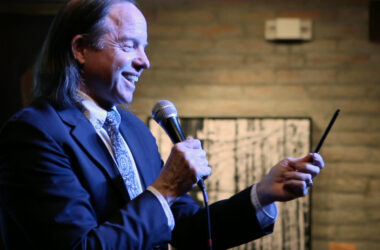Class 16: A Life to Live
[su_icon icon=”icon: link” color=”#ff1259″ size=”20″ shape_size=”12″ url=”https://youtu.be/W7Kk_QHGORI?t=14s” target=”blank”]Video[/su_icon]Hi, welcome back to the online Wheel of Life retreat. I’d like to thank Alison for coming and translating. We’re on session 16, which is called “A Life to Live.” Now you see this group of people just walking down the street and each one is walking through the Wheel of Life.
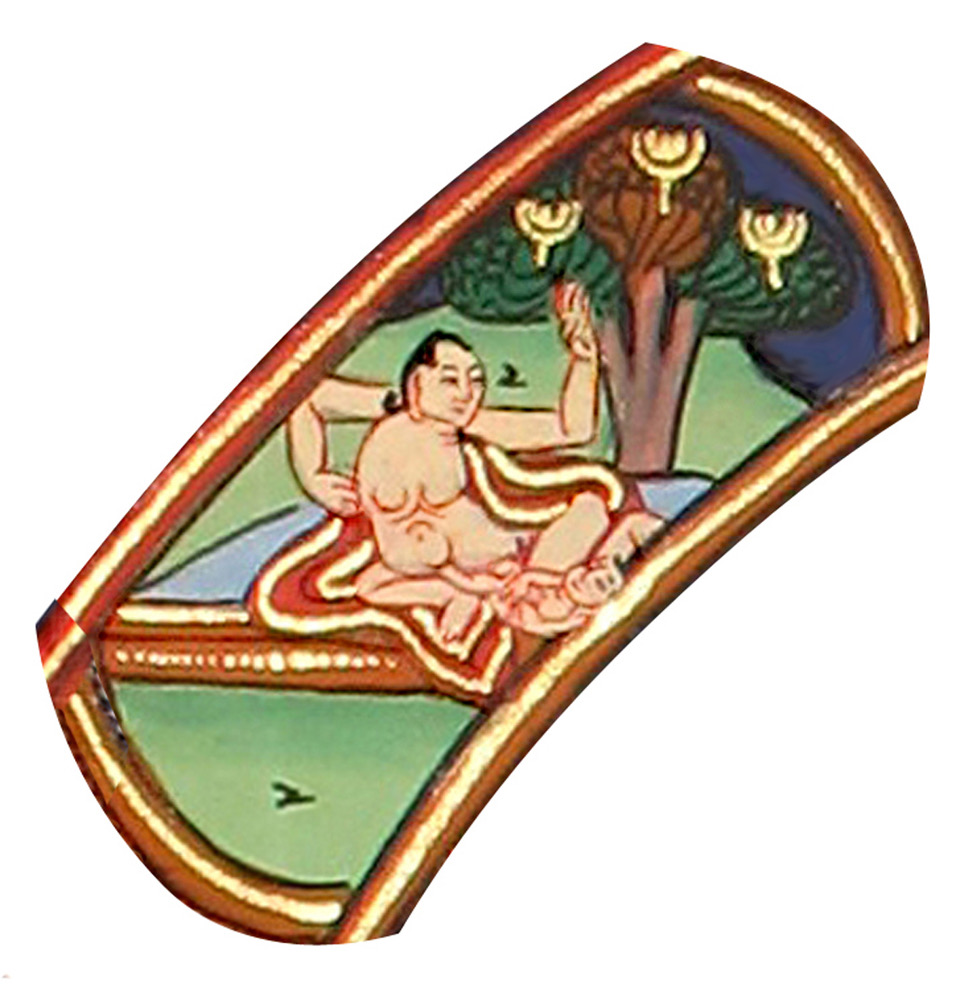 And pretty much in only two of the links, we cover a whole human life. Those two links… just before them comes link number ten, and you can see it here—this is my kid painters from Nepal—and they have painted … this lady is supposed to be a pregnant lady, and she represents link number ten, chupa sipa (BCU PA SRID PA). chupa (BCU PA) means “number ten.” sipa (SRID PA) is a difficult word. It has been mistranslated many times. It can mean “possible,” it can mean “becoming,” it can mean “your whole life.”
And pretty much in only two of the links, we cover a whole human life. Those two links… just before them comes link number ten, and you can see it here—this is my kid painters from Nepal—and they have painted … this lady is supposed to be a pregnant lady, and she represents link number ten, chupa sipa (BCU PA SRID PA). chupa (BCU PA) means “number ten.” sipa (SRID PA) is a difficult word. It has been mistranslated many times. It can mean “possible,” it can mean “becoming,” it can mean “your whole life.”
And it doesn’t mean any of those here. I think it was a big breakthrough when my own teacher taught me, he said in this case you have to think that the word sipa means “karma which is ripe.” Back in link number two, we had karma which was like a seed that you just put under the ground. And we translated that as “fresh karma.” nyipa duje kyi le (GNYIS PA ‘DU BYED KYI LAS) is fresh karma. And remember, we put the seed under the ground in the spring, watermelon seed, and then it rained and the water touched the seed, and it woke up all the workers in the factory inside the seed. I pictured them—they are like [yawns], they are waking up, and then the supervisor wakes up. He’s like, “Wake up everybody—we got work to do, we’ve got to get ready to push this sprout out of this seed.”
And so during those few months’ time after the water touches the seed, strange things are happening inside of the seed. We finished those two “preparing the factory to open.” They were called gyepa sepa gupa lenpa (BRGYAD PA SRED PA DGU PA LEN PA)—link number eight and link number nine. We took the good seeds and did coffee meditation. “I’m happy, I helped someone.” And on top of that we did a high-powered understanding about seeds, which makes good seeds open faster and bigger.
[su_icon icon=”icon: link” color=”#ff1259″ size=”20″ shape_size=”12″ url=”https://youtu.be/W7Kk_QHGORI?t=4m45s” target=”blank”]Video[/su_icon]With negative seeds in the picture of the Wheel of Life, link number eight and nine, we did sort of a negative coffee meditation. We were like, “Oh, I’m glad I’m eating meat, I will get stronger.” And then even more terrible, we think there’s no such thing as karma, the pen comes from the pen. “Even if I kill an animal to eat it, I don’t believe anything will happen to me.” So because of those two ideas, those bad seeds in The Wheel of Life get stronger and stronger, and at link number ten … let’s go to the book, let’s go to the text.
It says chupa sipa ni (BCU PA SRID PA NI)— “What is link number ten?” Which is called “ripe karma.” ngar duje kyi namshe la le kyi bakchak gu (SNGAR ‘DU BYED KYIS RNAM SHES LA LAS KYI BAG CHAGS BSGOS)—earlier in the wheel, the second link, which is called duje (‘DU BYED) in Tibetan, and sanskara (saṃskāra संस्कार) in Sanskrit. Remember, link number one was when you walk into the kitchen and your husband yells at you and you say, “I didn’t do anything, I don’t know why he is yelling at me.” And that’s link number one, which is misunderstanding where he’s coming from. That misunderstanding pushes link number two and she makes karma. How? She says, “I’m not stupid, you’re stupid” to her husband.
So the du je in the text here, the sanskara, is the moment that she says “I’m not stupid, you’re stupid.” And then the bakchak (BAG CHAGS), which means “the seed of the karma,” is pressed on the mind. Okay, my dog is not only blind and deaf, now sometimes he poopoos in the house by accident. Sometimes on the carpet. And you know, we try to lift the poopoo off very carefully with the toilet paper, but still a little bit of smell will rub into the carpet. So the verb here gupa (BSGOS PA) means that smell gets “rubbed” into the carpet. In this case, the karma of saying “I’m not stupid, you’re stupid” gets rubbed into our mind, and this is going to be important later.
We’ve been talking about the third link, which is one of the monkeys, and that monkey represents your mind entering your mother’s womb. But it can also represent the carpet, where the stinky has rubbed into the carpet. So at the moment that the wife says, “I’m not stupid, you’re stupid,” that karma is rubbed into the mindstream, and that’s another meaning of the third link. So the third link, first we understand it as the mind coming into my mother’s womb. But we can also understand the third link as the mind in which the seed is pressed when she said “I’m not stupid, you’re stupid.” Then at that moment when the seed is pressed into the mind, “I’m not stupid, you’re stupid,” it’s like the watermelon seed was just put under the dirt.
[su_icon icon=”icon: link” color=”#ff1259″ size=”20″ shape_size=”12″ url=”https://youtu.be/W7Kk_QHGORI?t=10m17s” target=”blank”]Video[/su_icon]Then, what’s the water? What’s the fertilizer? We finished it in the last class. In the last class, we finished what’s the water and what’s the fertilizer. And remember, with a bad seed it’s two different things, like she told her friend, “My husband yelled at me, but I yelled back at him. Ha ha ha.” And her friend says, “Aren’t you sorry you yelled at your husband?” “No, no, I’m happy, he deserved it.” It’s like she’s doing a negative coffee meditation. And she has no idea that her kids are going to be bad for many weeks because of what she said to her husband. So that bad seed, si len gyi su tab (SRID LEN GYIS GSOS BTAB)—the bad seed now has been given water and fertilizer by her negative coffee meditation and by her misunderstanding.
And now that seed from link number two, which is “I’m not stupid, you’re stupid,” It becomes tu chen du song (MTHU CAN DU SONG). The seed becomes tu (MTHU). tu means “tremendous power.” Like nuclear power. Then what power does it have now after her negative coffee meditation? chi may lu pen (PHYI MA’I LUS ‘PHEN)—now that seed can shoot a new lifetime, it can project a new lifetime. And that’s the meaning of chupa sipa, link number ten. It’s represented by a pregnant woman, but that woman’s big belly represents a big seed ready to open. Then the seed splits open, the spout comes out, and we see the picture here of a child being born. I think a lot about these images, like an arrow in the eye or a baby coming out of a woman.
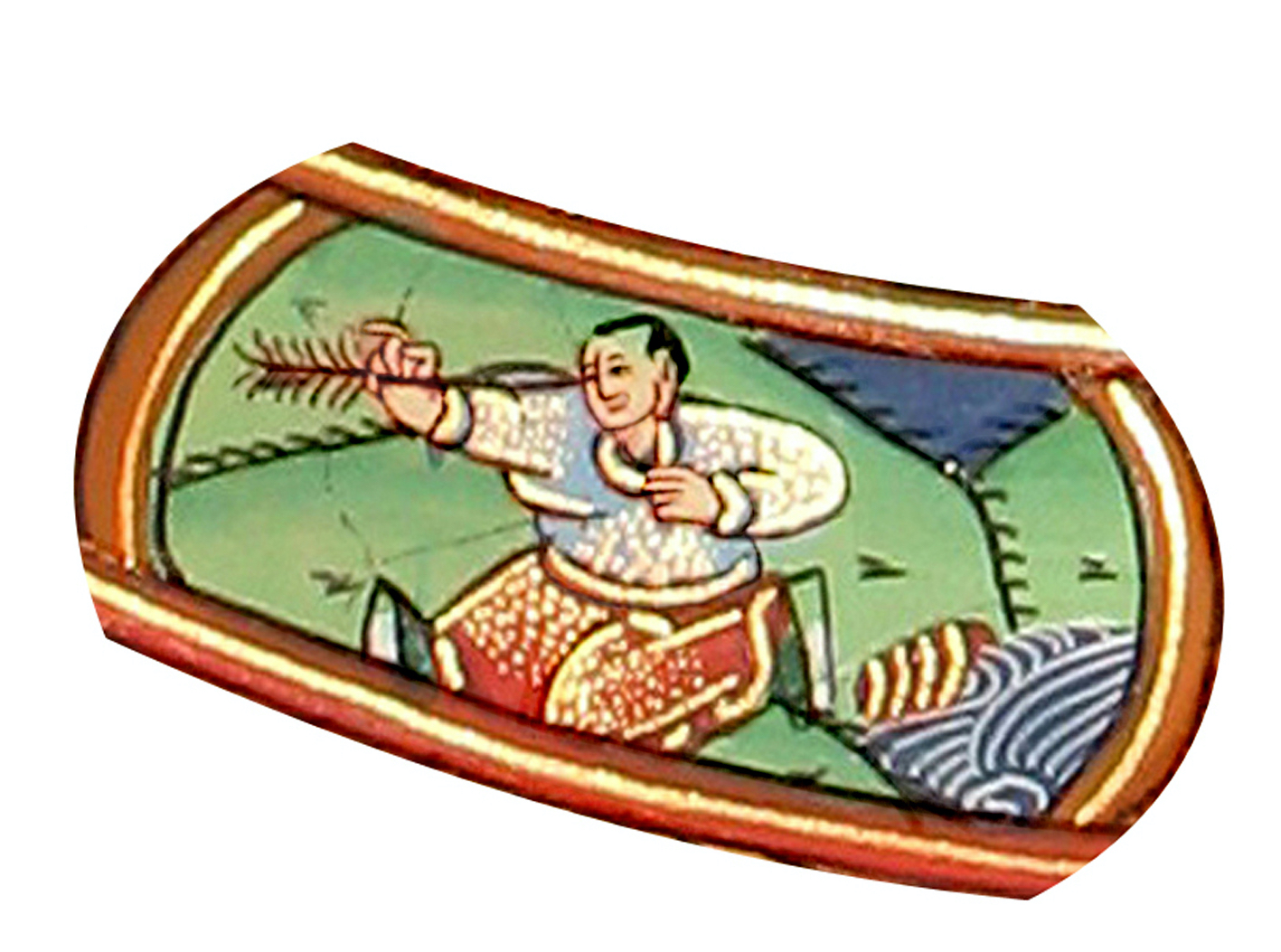 In these ancient paintings, these must have been very very shocking. They didn’t have videos, but I think if Buddha had a computer and video he would have made a movie about this Wheel of Life and not not paintings. And I think some day it would be interesting to make a real evocative movie, like a big emotional movie where somebody has the arrow in their eye … in fact, online I did try to find someone who got shot with the arrow. It did happen once and the person went to the hospital. But these pictures are supposed to freak us out, you know, like, “AH!” When you see this picture of a baby coming out of a woman, and the woman’s body is being torn apart, then we’re supposed to think, “I don’t want to do that again.”
In these ancient paintings, these must have been very very shocking. They didn’t have videos, but I think if Buddha had a computer and video he would have made a movie about this Wheel of Life and not not paintings. And I think some day it would be interesting to make a real evocative movie, like a big emotional movie where somebody has the arrow in their eye … in fact, online I did try to find someone who got shot with the arrow. It did happen once and the person went to the hospital. But these pictures are supposed to freak us out, you know, like, “AH!” When you see this picture of a baby coming out of a woman, and the woman’s body is being torn apart, then we’re supposed to think, “I don’t want to do that again.”
What don’t you want to do again? You don’t want to be the woman or you don’t want to be the baby? I don’t want to be either one. Okay? chu chikpa kyewa (BCU GCIG PA SKYE BA) means “now the seed is cracking open,” the fat seed, and now a child is coming out. The text says detar su tabpe (DE LTAR GSOS BTAB PAS)—now that the seed was given its water and its fertilizer by the negative coffee meditation, yang si druppay le nu pa tu chen du sonwa de la ten ne (YANG SRID ‘GRUB PA’I LAS NUS PA MTHU CAN DU SONG BA DE LA BRTEN NAS)—based on that karma now being totally ripe, kye ne shi-po gang rung du dang po namshe nying tsam jar (SKYE GNAS BZHI PO GANG RUNG DU DANG POR RNAM SHES NYING MTSAMS SBYAR)—then the mind makes the crossing into one of the four kinds of birth.
And the moment after the crossing we call rebirth, link number eleven. You could say birth. You could say rebirth. “Geshe-la, the first time it happened, it wasn’t a rebirth, right?” There is no first time. We have been here countless times, there is no beginning. The first time I heard that it was very uncomfortable for me. We like to think that there was a big bang or God made the world in six days or something. It makes us feel comfortable if we think there was a beginning. But it’s not logical. Nothing can start unless something else moves before that. So you could really translate this link number eleven, you could always translate it as “rebirth.” Now the text says “into one of the four kinds of birth.” And this is a popular topic in the ancient Abhidharma texts. And because we don’t know the four kinds of birth, and he doesn’t mention them in the text, I thought we should go to another book and get a nice commentary on those four.
[su_icon icon=”icon: link” color=”#ff1259″ size=”20″ shape_size=”12″ url=”https://youtu.be/W7Kk_QHGORI?t=18m41s” target=”blank”]Video[/su_icon]So we’re going to follow the Tibetan here to the commentary. chir kye ne la ye na (SPYIR SKYE GNAS LA DBYE NA)—you can divide all the kinds of birth into four. And I remember this was the first book I ever studied with my teacher. We started 45 years ago, and it took us 12 years to finish this book. So kye ne (SKYE GNAS) was always a confusing word for me. kye (SKYE) means “born.” ne (GNAS) means “location.” After many years he learned to translate it more correctly. It’s not “location” of birth; it’s the “type” of birth. So here’s the name of the four: ngel ske, gong kye, dzu kye, tru sher kye dang shi (MNGAL SKYES, SGONG SKYES, RDZUS SKYES, DROD BSHER SKYES DANG BZHI).
(1) The first one is called ngel kye (MNGAL SKYES). ngel (MNGAL) means “a womb,” like a human mother’s womb. kye (SKYES) is the past tense of born so “born in the past” in the womb, born in the womb.
(2) Then gong kye (SGONG SKYES). gong (SGONG), which is sometimes split into go nga (SGO NGA), means “egg.” So some beings are born from eggs, some beings are born from wombs. By the way, in Buddhism the real birth is at the moment of conception. Then there’s a second birth out of the womb or out of the egg. But it’s the conception which is when the baby starts. There’s a living sentient being at the moment of conception.
(3) The third one is called dzu kye (RDZUS SKYES). Sometimes it’s called dzu te kyepa (RDZUS TE SKYES PA). dzu te kye pa. And it means “miraculous birth.” For example, the Christians believe that Jesus was born without a father … without sex. And Hindus believed that the great yoga master Patanjali was born in the holy water, he appeared in the holy water that his mother offered. That water offering with your hands is called anjali. And pat means “fell down.” So his name, his whole life he was called “the guy who fell down from the sky into the water.” Patanjali. Then those people are born complete.
(4) Then dru sher le kyewa (DROD SHER LA SKYES BA) That means, in the summertime when the weather is warm and there’s lots of rain puddles on the ground, the ancient people, they couldn’t see the eggs of the insects, so they called it “a birth from warmth and moisture.”
[su_icon icon=”icon: link” color=”#ff1259″ size=”20″ shape_size=”12″ url=”https://youtu.be/W7Kk_QHGORI?t=23m12s” target=”blank”]Video[/su_icon]So there’s the four kinds of birth: (1) birth from a womb; (2) birth from an egg; (3) miracle birth, complete; and (4) birth from warmth and moisture. Now just for fun, I thought you guys would like to continue reading this text, which is related to the text being translated by our translator Sugeng Shi from Singapore. Same author from about five hundred years ago. Okay, so I thought you’d like to hear some discussion about these four.
yidak la ngel kye kyang yu de (YI DVAGS LA MNGAL SKYES KYANG YOD DE)—hungry ghosts also have birth from a womb, it’s possible. They are not just born from miracles—usually we think they are just born suddenly. He says “they can also be born from a womb.” So “also” implies that usually they are born another way, but they also are born from a womb. yidakmoy tok ju le (YI DVAGS MO’I RTOGS BRJOD LAS)—there’s an avadana (avadāna) … these are called “stories of spiritual people” from ancient India, and this one is called the story of “The Lady Hungry Ghost.” And there’s a famous verse that she used to recite. dak gi nyinpar bu nga gya, tsen mo yang nin nga gya te, su kyang dak la tsimpa me (BDAG GIS NYIN PAR BU LNGA BRGYA, MTSAN MO YANG NI LNGA BRGYA STE, ZOS KYANG BDAG LA TSIM PA MED). I give birth from a womb to five hundred kids every day.
Five hundred hungry ghost kids come out of my womb every day, in the daylight. tsen mo yang ni nga gya te (MTSAN MO YANG NI LNGA BRGYA STE)— And at night, in the dark, I have another five hundred. From her womb. You might think, “How does hungry ghost mom take care of her one thousand per day hungry ghost kids?” su kyang (ZOS KYANG)—I eat them. dak la tsimpa me (BDAG LA TSIM PA MED)—but still I don’t feel full. che sungpay chir (CES GSUNGS PA’I PHYIR) mi la ni kye ne shi ga yu de (MI LA NI SKYES GNAS BZHI GA YOD DE)—all four kinds of birth are found with human beings.
They have all four kinds. And this is, by the way, a very standard and famous Abhidharma discussion. mi pel cher ngel ne kye (MI PHAL CHER MNGAL NAS SKYE)—most humans, as we know, are born from the womb. dzu kye—some are born miraculously. I used to translate that as “born complete” because they’re just born as a complete person. And they give the example of the Buddhist master named Aryadeva. Famous disciple of Nagarjuna. I don’t know the story, we can look it up some day, but apparently he was born miraculously.
[su_icon icon=”icon: link” color=”#ff1259″ size=”20″ shape_size=”12″ url=”https://youtu.be/W7Kk_QHGORI?t=27m45s” target=”blank”]Video[/su_icon]gyelpo chiwo kye tabu dru sher le kye (RGYAL PO SPYI BO SKYES LTA BU DROD GSHER LAS SKYES)—Then there was a king who was born from the top of the head of his father from warmth and moisture. Then there were two Arhats, or two people who became Arhats. In Tibetan, they’re called Drak (BRAG) and Nyeway Drak (NYE BA’I BRAG), and they were born from eggs. dundro la yang shi ga yu (DUD ‘GRO LA YANG BZHI GA YOD)—animals also have four kinds of birth, all four. nyelwa dang hla dang bardo la dzu kye kyi kyab te (DMYAL BA DANG LHA DANG BAR DO LA RDZUS SKYES KYIS KHYAB STE). But all hell beings, all devas, and all bardo beings are born complete. Hell beings, devas, and bardo beings, they are always born miraculously. Hell being, deva, and bardo.
So bardo (BAR DO) being … remember it is that one in the moment after you die and you go into the bardo. For seven days. Up to 49 days. Then he quotes the Abhidharma Kosha, which is the most famous book of Abhidharma nowadays. It’s about two thousand years old. nyelwa nam dang hla nam dang, sipa parma dzu te kye (DMYAL BA RNAMS DANG LHA RNAMS DANG, SRID PA BAR MA RDZUS TE SKYE)—all hell beings, all devas, and all bardo beings are born complete. Miraculously.
[su_icon icon=”icon: link” color=”#ff1259″ size=”20″ shape_size=”12″ url=”https://youtu.be/W7Kk_QHGORI?t=29m58s” target=”blank”]Video[/su_icon]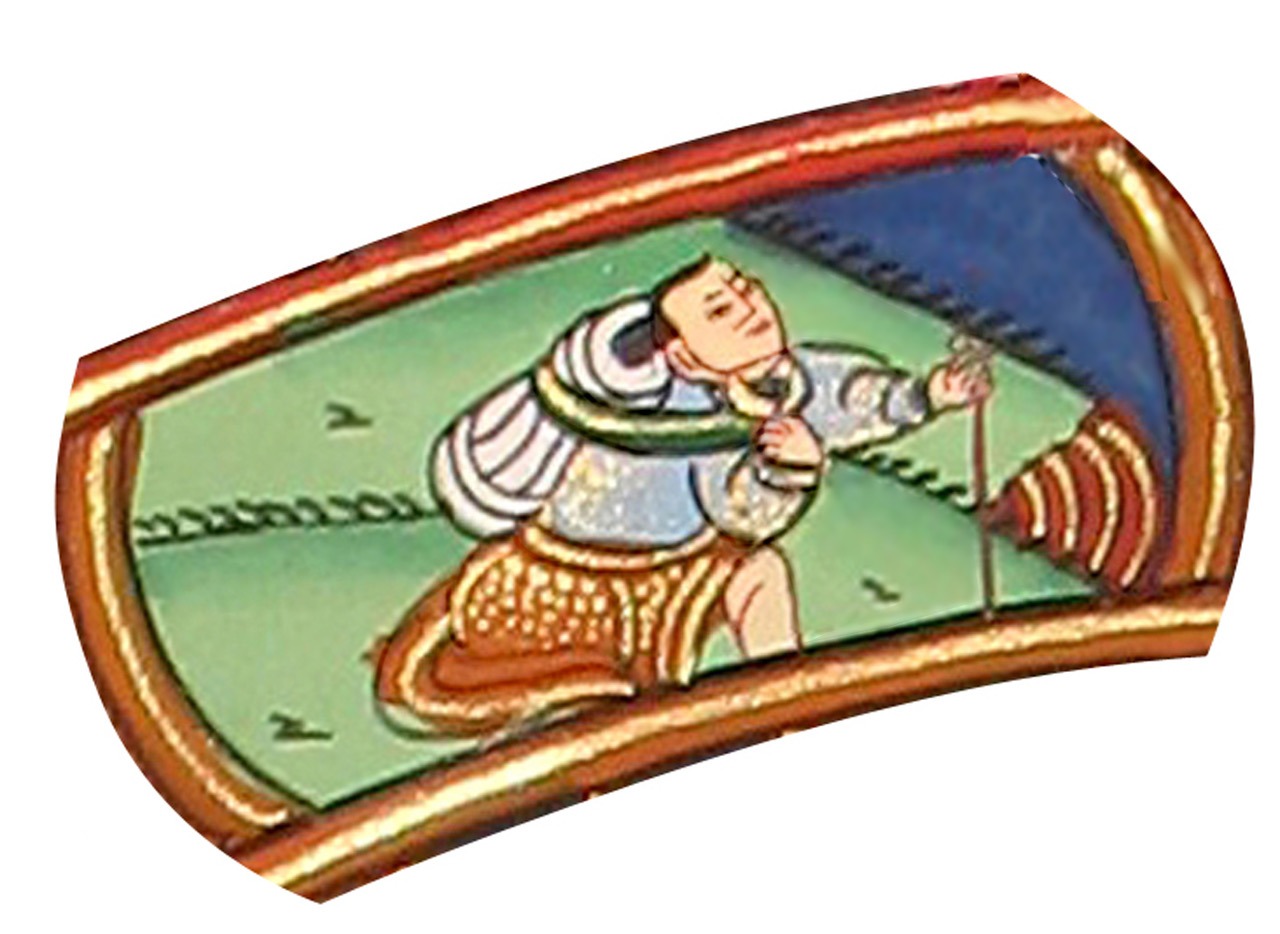 Which brings us to link number twelve, the last of the twelve links. The picture you see is of somebody carrying a big package on their back. This represents the way that people were buried, or how they treated dead bodies in ancient India and also in Tibet. If you think your job is bad, at least you are not carrying corpses to the mountain or to the charnel ground. Charnel ground means a very terrible place where you throw dead bodies; you just throw them on the ground. I’ll tell you a story.
Which brings us to link number twelve, the last of the twelve links. The picture you see is of somebody carrying a big package on their back. This represents the way that people were buried, or how they treated dead bodies in ancient India and also in Tibet. If you think your job is bad, at least you are not carrying corpses to the mountain or to the charnel ground. Charnel ground means a very terrible place where you throw dead bodies; you just throw them on the ground. I’ll tell you a story.
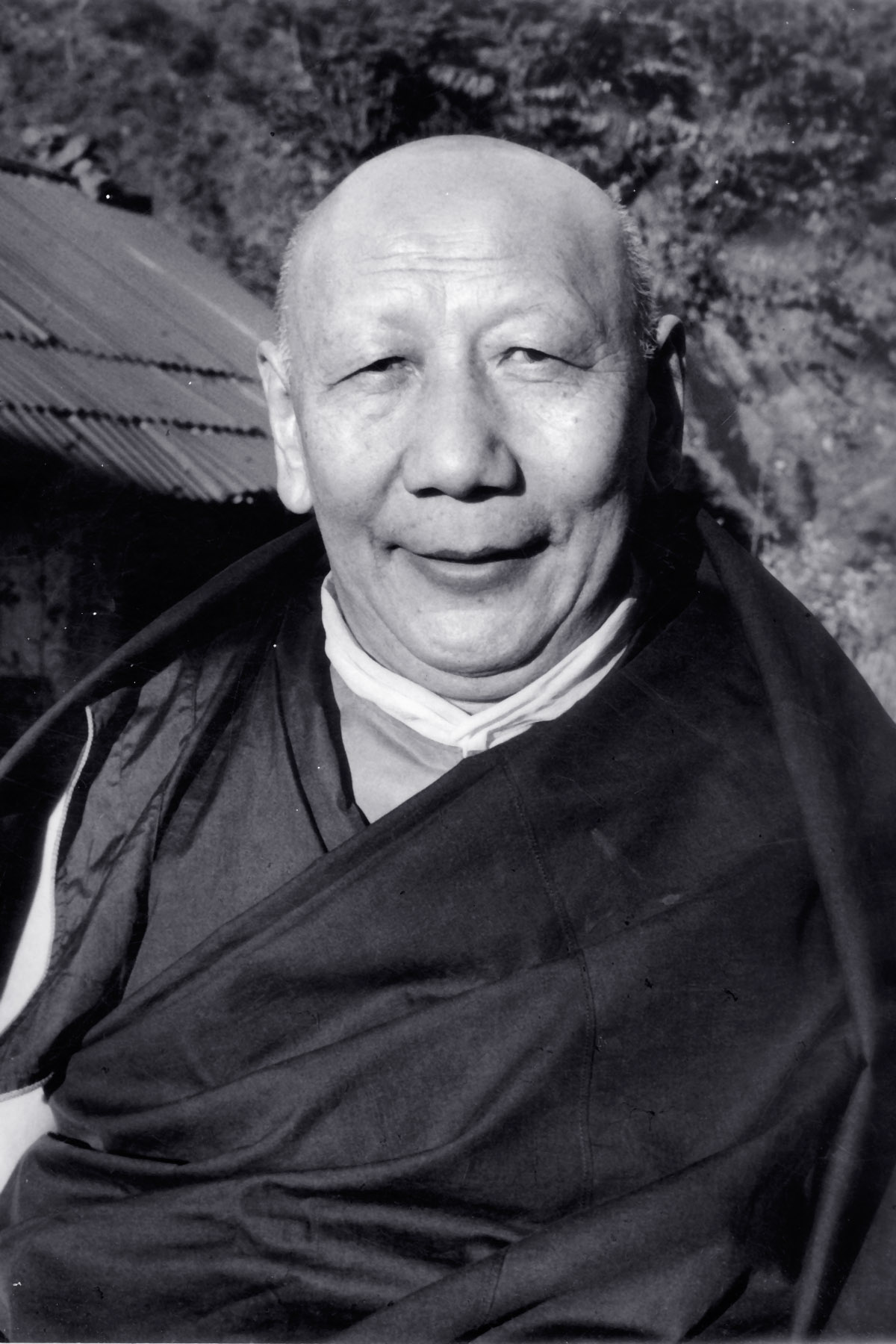
When I was a young monk, actually I was living in a monastery, but I wasn’t a monk yet—small Mongolian monastery in America—and the senior teacher of the Dalai Lama, he was very, very famous for secret teachings, and he was very, very serious. Then I got the job to be his driver for one day and I have to drive him for two or three hours, and everyone told me “don’t talk to him.” I was very young, I was 26. Why I remember you will find out. They said, “Don’t talk to him.” I said, “Why?” “He is Yamantaka. He’s the fierce Buddha! Arrarrrghhhh! Don’t talk to him!” Then two famous teachers got in the car, but they got in the back. Why doesn’t the big teacher sit in the back? And they told me in India the big person always sits in front. So he got in next to me. And I was like [nervous, scared].
I tried not to talk, then we started to drive, and one of the lamas in the back, he said, “This is Mike.” Then the teacher goes, “Huh!” Then he says “Oh, Mike is very good. He understands Abhidharma.” Then the Dalai Lama’s teacher is like “Huh!” “ngapo nam ni don shi la.” (LNGA PO RNAMS NI DON BZHI LA). He quoted the first line of the second chapter. I was memorizing the Abhidharma Kosha at that time. I never finished, but I finished three or four chapters. I just finished memorizing that line. Then I thought “Oh, that’s the first line of the second chapter” and explained it, and he was like “hmmm.”
Then we drove for some time and the two big lamas in the back fell asleep. And the Dalai Lama’s teacher started to talk to me, and we had a wonderful talk for like two hours. And he said “Tell me everything we see in America, tell me what it is.” And we passed the cemetery with many crosses and he said, “Oh, what’s that? Why many crosses?” Then I said, “That’s a cemetery.” He says, “Why they have those crosses?” I said, “Well, they buried the body there.” “What! The whole body?” “Yeah.” “Not the ashes?” “No, no, they believe that the body, the person will come alive at the end of the world and they will go to heaven.”
Then he looked at me and said, “Ha, ha, ha! What a waste of good living space! People can live on that land! Why did they put the dead body under there?” Then I’m like, “Well, what should we do with the dead body?” And it’s what you see in this picture. “We cut all the pieces up, we mix it with tsampa flour,” with flour, “and we carry it to the top of the mountain, and we give it to the birds and then it’s a good karma. That person’s body is not wasted, that person’s body is a gift to to these wild animals.” So that’s what’s happening here in this picture.
[su_icon icon=”icon: link” color=”#ff1259″ size=”20″ shape_size=”12″ url=”https://youtu.be/W7Kk_QHGORI?t=36m44s” target=”blank”]Video[/su_icon]de ne chu nyipa ga shi chi rikpay tendrel rim gyi druppa yin (DE NAS BCU GNYIS PA RGA SHI CI RIGS PA’I RTEN ‘BREL RIM GYIS ‘GRUB PA YIN)—then we come to the last link, which is link number twelve. ga shi (RGA SHI). ga shi means “aging and death.” And technically it’s called “death, maybe with aging.” ga shi chi rikpay tendrel (RGA SHI CI RIGS PA’I RTEN ‘BREL) means … I asked my teacher, “Why do they call it “death with maybe some aging?” Then my teacher said, “Well sometimes kids die in the womb”, so we don’t know. That’s why Buddha didn’t make thirteen links. Some people die in the womb, they don’t have time to get old.
de yang gawa ni pungpoy ne skab rim gyi shen du gyur shing minpa yin (DE YANG RGA BA NI PHUNG PO’I GNAS SKABS RIM GYIS GZHAN DU ‘GYUR ZHING SMIN PA YIN)—what is the definition of aging? The body goes through change, change, change, change—it never stays the same. It falls apart step-by-step, day-by-day. Now the definition of death: shiwa ni punpoy ri tun dor ba-am jikpa la ser (SHI BA NI PHUNG PO’I RIS MTHUN DOR BA’AM ‘JIG PA LA ZER)—when we say death, what we mean is that the flow of the same body and mind is interrupted. So we don’t say the body died or the mind stopped. It takes on different clothing. So it’s very interesting that death is not the end of the body or the mind. The mind shifts, the physical form shifts, but life does not end and cannot end. You have lived for time with no beginning and you will live for time with no end.
[su_icon icon=”icon: link” color=”#ff1259″ size=”20″ shape_size=”12″ url=”https://youtu.be/W7Kk_QHGORI?t=39m35s” target=”blank”]Video[/su_icon]I’d like to end this session with kind of a review. And I’m going to be using special images. We’ve had all twelve links now, And I’ve taught them in groups, on different days. And I’d like to just review that because it’s going to be important tomorrow and the next days. So in this first picture here you see of the twelve links and then… except this morning I learned how to mark them with a yellow marker, so it looks like it was done by a kid, but it’s done by me, okay?
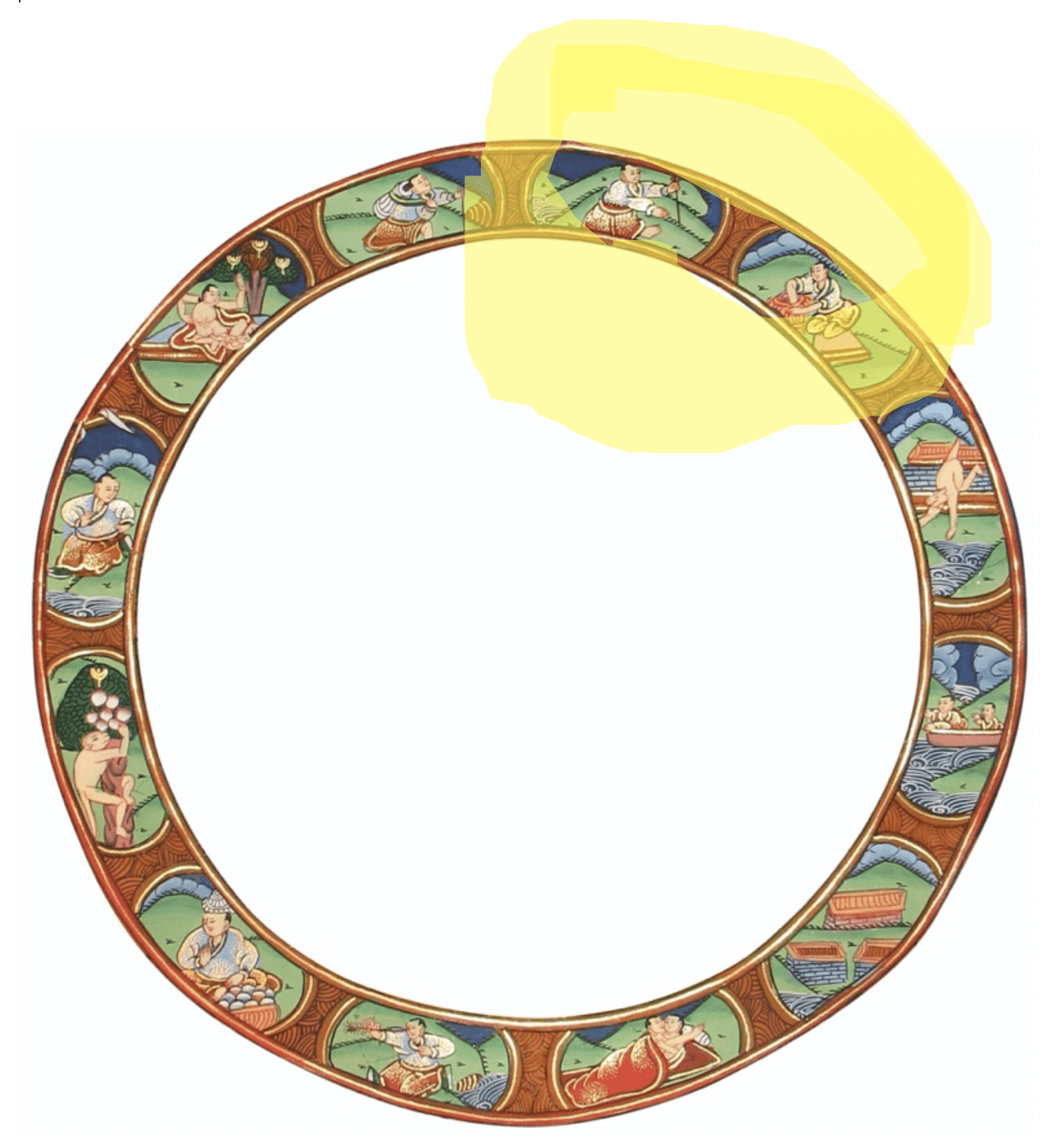 First, I want to draw your attention that the first two links hang together. Again you can call it ignorance and karma. But I’d like to call it misunderstanding and planting seeds. Fresh seeds. And again, I want you to think that these two kind of hang together. You know, the wife comes in the kitchen. She’s tired. She comes home from work. She says, “Give me a hug” … no she just reaches out like this. She doesn’t say anything. But she’s thinking, “I will get a hug from my husband.” Then suddenly he says, “You’re so stupid,” and in that moment, she misunderstands where that comes from. She says, “I didn’t do anything and he yelled at me!” But she did do something; she yelled at her kids last week. Then misunderstanding triggers the second link. Then she says, “I’m not stupid, you’re stupid.” So those two links kind of hang together.
First, I want to draw your attention that the first two links hang together. Again you can call it ignorance and karma. But I’d like to call it misunderstanding and planting seeds. Fresh seeds. And again, I want you to think that these two kind of hang together. You know, the wife comes in the kitchen. She’s tired. She comes home from work. She says, “Give me a hug” … no she just reaches out like this. She doesn’t say anything. But she’s thinking, “I will get a hug from my husband.” Then suddenly he says, “You’re so stupid,” and in that moment, she misunderstands where that comes from. She says, “I didn’t do anything and he yelled at me!” But she did do something; she yelled at her kids last week. Then misunderstanding triggers the second link. Then she says, “I’m not stupid, you’re stupid.” So those two links kind of hang together.
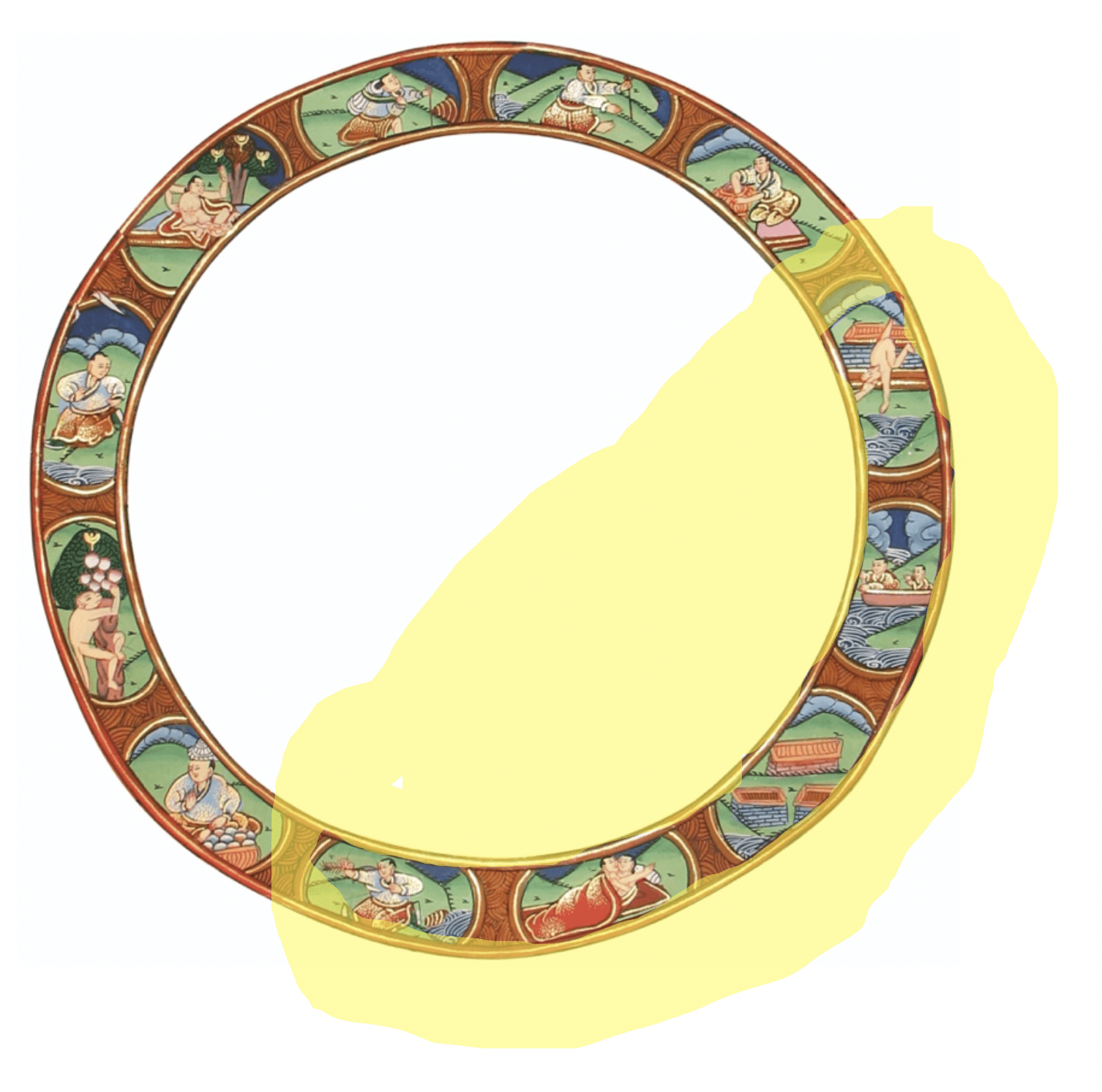 Okay, now the next image, there’s a poorly written yellow cloud around links three up to seven. And these are the five links that are kind of our equipment during life. They’re what we use to express ourselves. In the third link we get a mind, in the fourth link we start to get a body along with that mind inside our mum, in the fifth link our eyes, ears, nose—we start to get our equipment for contacting the outside world. In the sixth link we used those instruments to make contact with the outside world. And then in the seventh link, we start to have feelings about what we contacted. So you can kind of get a feeling that link three to link seven kind of hang together, they are the equipment that we need to be alive.
Okay, now the next image, there’s a poorly written yellow cloud around links three up to seven. And these are the five links that are kind of our equipment during life. They’re what we use to express ourselves. In the third link we get a mind, in the fourth link we start to get a body along with that mind inside our mum, in the fifth link our eyes, ears, nose—we start to get our equipment for contacting the outside world. In the sixth link we used those instruments to make contact with the outside world. And then in the seventh link, we start to have feelings about what we contacted. So you can kind of get a feeling that link three to link seven kind of hang together, they are the equipment that we need to be alive.
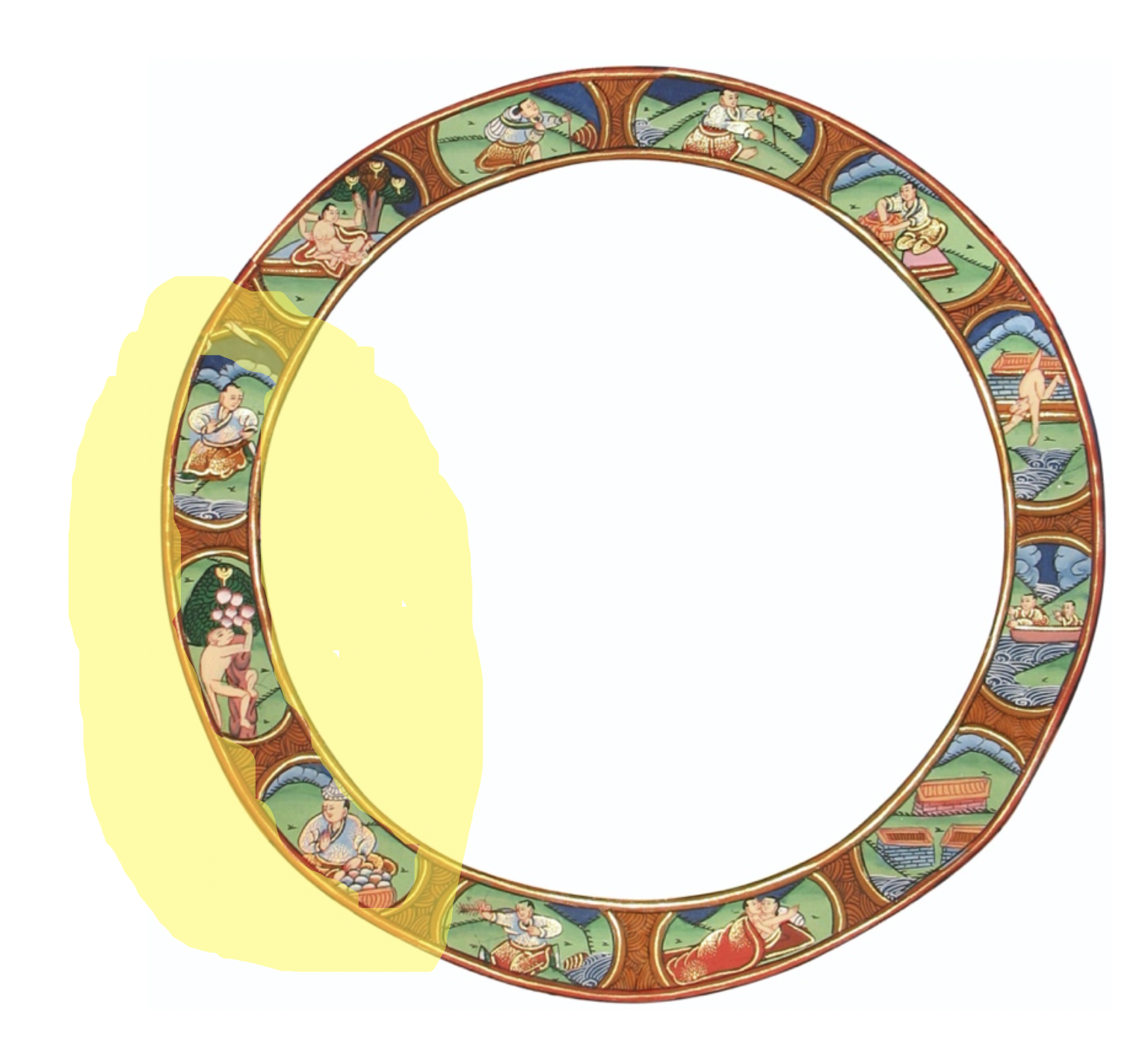 In the next image, I drew a yellow cloud around links eight, nine, and ten. And really when you think about it, the most important version of eight, nine, and ten is at the end of our life. We have seeds in our mind from our whole life including, “I’m not stupid, you’re stupid.” Then we talked about how, it’s very important which seed is activated in the last moment of our conscious life. So as you see in the image here, link eight, nine, and ten kind of hang together. Ten is that big fat seed that already got a lot of water and fertilizer, but didn’t open yet. And then eight and nine are like the water and fertilizer on that seed.
In the next image, I drew a yellow cloud around links eight, nine, and ten. And really when you think about it, the most important version of eight, nine, and ten is at the end of our life. We have seeds in our mind from our whole life including, “I’m not stupid, you’re stupid.” Then we talked about how, it’s very important which seed is activated in the last moment of our conscious life. So as you see in the image here, link eight, nine, and ten kind of hang together. Ten is that big fat seed that already got a lot of water and fertilizer, but didn’t open yet. And then eight and nine are like the water and fertilizer on that seed.
Then if you think about it, link number eleven and link number twelve—rebirth, aging day-by-day after you are conceived, and then death—that’s a whole lifetime. Just eleven and twelve is a whole lifetime. Eleven is coming into the womb. But we already came into the womb in number three. So I want you to start to get this feeling that this is not one life from beginning to end like Shakespeare’s poem. Something else is going on here. Eleven and twelve are a whole life themselves. One and two kind of sound like they happen before your mind came into this womb.
So now the question comes, “How many lifetimes are in one turning of the twelve links?” And why it’s not just one lifetime like Shakespeare. To find out the answer you have to come back to tomorrow’s session, number 17!
See you then.







